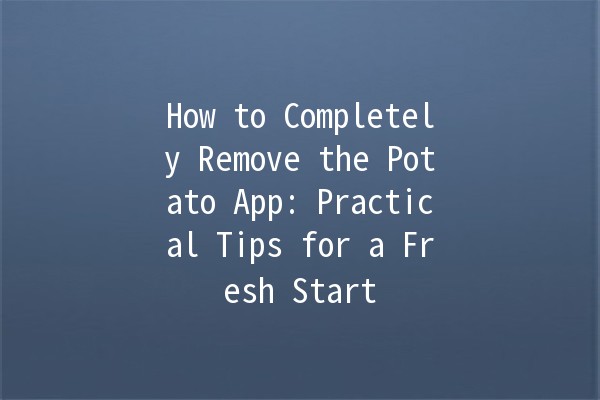In today's digital world, managing apps effectively is essential for both productivity and device performance. One app that has drawn attention is the Potato app, a versatile tool for various tasks. However, there could be reasons why you might want to completely delete it from your device. Whether you’re looking to reclaim storage space, improve performance, or simply move on to another solution, we’ve got you covered. In this article, we’ll explore practical tips to successfully remove the Potato app, ensuring a smooth process while keeping your device clutterfree.
Understanding the Need for Removal
Before diving into the steps, let’s discuss why you might want to remove the Potato app. Common reasons include:
Performance Issues: If the app is slowing down your device or causing crashes, removal might be the best solution.
Storage Space: App sizes can accumulate and take away valuable storage. Removing rarelyused apps can help mitigate this.
User Experience: Perhaps you’ve found a better tool that serves your needs more effectively.
Understanding your motivation will make the process of removal clearer and more purposeful.
Tips for Completely Removing the Potato App

Here are five effective tips that can enhance your app management skills and help you completely remove the Potato app from your device.
Before you proceed with uninstallation, it’s essential to back up any important data linked to the Potato app:
How to Back Up:
Utilize Cloud Storage: If the app allows, transfer data to a cloud service like Google Drive or Dropbox.
Export Data: Many apps provide export features for data. Check the settings menu for options.
Manual Save: For any data that's not easily exported, consider taking screenshots or copying information.
Example Application:
Let’s say you’ve been using Potato to manage your tasks. Before deletion, ensure that your task lists, reminders, or notes are either exported or copied to another app.
Once you’ve secured your data, the next step is to uninstall the app. Here’s how to do it:
For Android Devices:
Go to Settings > Apps > Potato > Uninstall.
Alternatively, you can longpress the Potato app icon on your home screen and select “Uninstall.”
For iOS Devices:
Longpress the Potato app icon until it wiggles.
Tap the "X" and confirm to delete the app.
Example:
If you have multiple apps, the same process can be used for each one. Regularly cleaning up unnecessary apps can lead to better device performance.
After uninstalling, some residual files may remain. It’s crucial to clean these out to maximize storage:
Steps to Clean Residuals:
File Manager Apps: Use a file manager on Android to search for leftovers.
Settings Cleanup: On both Android and iOS, navigate to storage settings to see if any remnants are taking up space.
Thirdparty Cleanup Tools: Consider installing a trusted cleanup tool to automate the deletion of any leftover files.
Example Application:
Using a file manager, navigate to your internal storage, look for folders named after the Potato app, and delete them manually.
If you have associated accounts, consider removing app permissions and resetting related settings:
How to Reset:
Account Settings: Go to your account settings (Google, Apple ID) and remove the Potato app’s access.
Email Notifications: Unsubscribe from any associated newsletters or notifications if you no longer wish to receive them.
Example:
If you were signed in with a Google account, navigate to your Google account settings, and remove any consent for the Potato app.
Now that you’ve removed the Potato app, consider what you’ll use in its place. Exploring alternatives can improve your productivity significantly:
Alternatives to Consider:
Todoist: Great for task management with a clean UI.
Trello: Perfect for project management with collaborative features.
Google Keep: Ideal for notes and reminders, seamlessly integrating with other Google services.
Example Application:
If your goal was task management with Potato, transitioning to Todoist could enhance your workflow with its robust feature set.
Frequently Asked Questions
Sometimes an app may be stubborn. If uninstall doesn’t work through normal channels, consider booting your device in safe mode and retrying the uninstallation.
If you did not back up your data prior to deletion, any saved information within the Potato app will be lost. Always back up your data first.
Yes, you can also delete an app directly from your home screen by longpressing the icon and selecting the delete option for most smartphones.
Yes, leftover files can consume storage space and potentially slow down your device. It’s best to remove them after uninstalling any app.
Delete unused apps regularly, clear your cache, and manage updates to keep performance optimal. Additionally, performing periodic checks on installed applications can help maintain device health.
Resetting account settings ensures that old permissions do not linger, potentially protecting your data and privacy from apps you no longer use.
Managing your applications can significantly enhance your digital experience, ensuring that you are only utilizing what you need. Removing the Potato app, as with any application, is a straightforward process if approached methodically. Follow these tips for a betterorganized device, increased performance, and ultimately, enhanced productivity. Whether you’re cleaning out old apps or just looking for something better, understanding the process can empower you in your digital life. Happy decluttering!